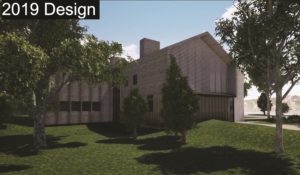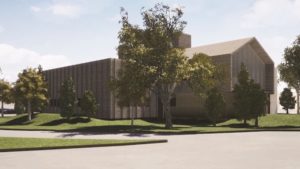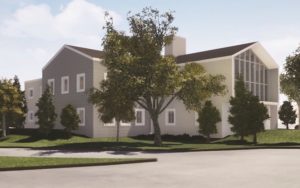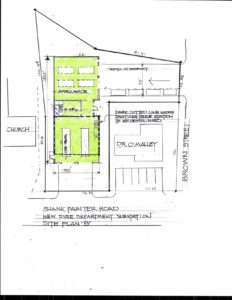PROVINCETOWN — About 300 people listened to speeches, watched a color guard raise the flag, and then took a freeform tour of the town’s new police station at 2 Jerome Smith Road on March 20.
Police Station
ANNUAL TOWN MEETING
Police Station, Housing Efforts Top Provincetown Agenda
It’s a full warrant for April 4; bring snacks and patience
PROVINCETOWN — Voters at annual town meeting on April 4 may feel like they’re at the civic version of a double feature. The main attractions will be the police station proposal in Article 6 followed by 10 different measures to address the housing crisis in articles 15 through 24.
Article 6 asks for authorization to borrow $8.5 million — to be added to the $8.6 million approved in 2017 — to build the station at Shank Painter Road and Route 6. A similar measure asking for $3.9 million failed in 2019 in two very close votes.
The 10 housing articles mostly fall into two categories: studying town-owned parcels for future housing and allocating new revenue streams. There is also a proposal to allow four-story residential construction along Shank Painter Road and a measure to purchase a 1.7-acre parcel at 288A Bradford St. for development.
A Difficult History
Provincetown’s recent history with police station planning has been difficult. The police dept. has been operating from a former funeral home at 26 Shank Painter Road since 1986. Town Manager Alex Morse and Police Chief Jim Golden have made a video about its conditions, online at provincetown-ma.gov/1111/Police-Station. Features include overworked electrical panels, outdated dispatch equipment, and a basement that becomes soaked with sludge on rainy days.
A 2017 town meeting vote approved $8.6 million for construction of a new station at 16 Jerome Smith Road, a town-owned parcel at Shank Painter and Route 6. That article passed easily, 206 to 35.
The cost estimate turned out to be invalid, however. A 13-page question-and-answer sheet prepared by the building committee and currently posted on the town website lists several reasons. “The estimate was inaccurate and misleading, was based on depressed 2016 estimates, and did not include a premium for working on the Outer Cape,” it says. “The architects who prepared the estimate themselves declined to bid.”
When town officials asked the 2019 annual town meeting for an additional $3.9 million, opinion splintered. Objections were raised to the design, the location, the cost, and the method of financing, which was split between a debt exclusion (raising the money from taxes beyond the 2.5-percent limit on increases) and free cash. The vote was 202 yes and 123 no — 15 votes short of the two-thirds majority needed for a debt exclusion.

According to this year’s Article 6, “This is the same project that was brought to town meeting in April 2019. The only difference is that … this funding will be paid entirely through a 2½ debt exclusion,” rather than using free cash for part of the cost.
After the 2019 vote, the building committee commissioned a more traditional “Cape Cod vernacular” alternative design. The original, more contemporary design got more than 80 percent of the nearly 1800 votes in an online poll. Both designs and interior floor plans are on the police station website.
The building committee estimates a “hard construction” cost of $13.5 million and $3.1 million in “soft costs,” which include architectural and engineering work, computers, equipment, and furnishings. Article 6, in combination with the earlier allocation, would authorize $17.1 million total debt for the project.
Housing Initiatives
Provincetown’s select board, community housing council, and Year-Round Market-Rate Rental Housing Trust have been working on articles for town meeting since October.
Two articles focus on town-owned land under and near the southern lanes of Route 6 between Conwell Street and Shank Painter Road. Article 19 is a nonbinding resolution on the potential removal of the two southern lanes in that stretch; Article 20 asks for $60,000 to pay a planning consultant.
Article 21 asks for $150,000 to study potential reuse of the Veterans Memorial Community Center, now home to the DPW, Council on Aging, and other town departments. Select board members Leslie Sandberg and Louise Venden favor turning the one-story structure into a two- or three-story building, with town offices on the ground floor and housing above.
Articles 22 and 23 ask for funds to study two smaller properties: 30 Creek Road and 189 Commercial St. Article 24 would allow inclusionary projects — that is, market-rate developments where at least one of every six units are deed-restricted to be affordable — to get a potential fourth story if they are in the town’s General Commercial zone.
Articles 15, 16, and 17 would each dedicate other funds for housing. Article 15 would impose a community impact fee of 3 percent of bookings on short-term rentals that are “professionally managed.” Article 16 would direct 30 percent of the town’s rooms tax revenues from hotels and short-term rentals to the town’s two housing funds. Article 17 would raise the “in-lieu” fees that developers pay to the affordable housing trust fund when they build multiple units of market-rate housing and don’t include affordable units.
Article 18 was apparently added just before the warrant closed. It would authorize a $1,575,000 debt exclusion to purchase a 1.7-acre parcel at 288A Bradford St. for “open space land and affordable/community housing.” The parcel belongs to Shaun Pfeiffer, and has been in his family since at least 1943, according to town records. A separate petitioned article from Jonathan Sinaiko of 292 Bradford St. asks the town to buy the parcel for the same purposes.
Appointments, Etc.
The only other petitioned article would change the way the finance committee is appointed. At present, the committee is a “standing committee of town meeting,” appointed by the town moderator. Article 25, submitted by Laura Rood, would have the moderator appoint three members and the select board and school committee each appoint two members and an alternate.
Current finance committee members would remain until their appointments expire.
Article 34, from the select board, would change the appointment of visitor services board members to eliminate nominations from various town organizations. The select board would instead simply appoint all the members.
Article 8, a $1.8-million debt exclusion, would fund the development of Cannery Wharf Park, previously known as East End Waterfront Park. The land was purchased from Elena Hall in 2019.
Article 12 asks for $115,000 to resurface the tennis courts at Motta Field and stripe two of the three courts for pickleball.
Article 14B seeks $450,000 to design and construct a barrier dune at Ryder Street beach. The Jan. 4, 2018 nor’easter sent seawater across this beach and down Gosnold Street into a giant pool at the Bas Relief Park. Dozens of homes and businesses were flooded. The dune would run from Ryder Street to the edge of the Crown and Anchor property to close the flood pathway.
HEADQUARTERS
Provincetown Reboots Police Station Plans
Video compares 2019 and 2021 designs, but there’s no cost update yet
PROVINCETOWN — Those who haven’t had the chance to see the notoriously scruffy conditions at the town’s police station, housed in a former funeral home since 1986, can now peek in from the comfort of their own homes.
Provincetown is rebooting its effort to build a new police station. The town has posted two videos at provincetown-ma.gov/1111/Police-Station, one a narrated walk-through of the current station at 26 Shank Painter Road, and the other a presentation of the new station designed for the corner of Shank Painter Road and Route 6.
The first video offers a 13-minute tour of the deficiencies of the current station, including an overloaded electrical system, antiquated dispatcher equipment, and a locker room and animal control room that are both subject to repeated flooding from rising groundwater.
Two possible designs are shown in the second video, a “2019 plan” and a “2021 plan” for a new station. The interior layouts are the same, but the 2019 plan has a contemporary design meant to evoke a fishing warehouse on a pier, while the 2021 plan features design elements intended to be more traditional, including a porch-style entryway, paned windows, and both shingles and siding on the exterior walls.

The videos are accompanied by a poll. As of Tuesday evening, Sept. 28, 945 people had voted, with the 2019 concept outpolling the 2021 concept by almost three to one. The poll was set to close on Wednesday, Sept. 29 before a 5 p.m. building subcommittee meeting to consider the results.
The town is progressing towards a vote on supplementary funding for the station at the annual town meeting in April 2022. An $8.6-million bond authorization passed at the April 2017 town meeting, but plans for the station went on hold after a subsequent $3.9-million additional funding authorization failed in April 2019.
“I think we are committed to doing as much as we can between October and April to make sure voters go into town meeting having as much information as they would like to have,” Town Manager Alex Morse told the select board this week.

“I’ve gotten a fair number of people who have called me, wanting to know why the building is designed the way it is, and what the requirements are,” said board member Leslie Sandberg. “There is no dollar amount yet, but there’s a number, $15 million, floating around — it could be more, it could be less, but that’s probably about where it is.”
Sandberg and select board member Louise Venden endorsed the idea of having several public information events throughout the winter.
A new cost estimate for the current station design is not yet available. In 2019, the total cost was supposed to have been around $12.5 million, but the price of many construction materials has risen dramatically during the pandemic.
PROVINCETOWN: THIS WEEK'S CURRENTS
Police Station Plans Back On
Meetings Ahead
Some Provincetown meetings are in-person only, some are remote only, and some are hybrid where you can choose to participate in person or through a remote link. Go to provincetown-ma.gov, click on the meeting you want to watch, and follow the instructions on the agenda.
Thursday, Sept. 23
- Planning Board, 6 p.m., Town Hall
Friday, Sept. 24
- Bicycle Committee, 10 a.m., virtual
Monday, Sept. 27
- Select Board, 6 p.m., Town Hall
Tuesday, Sept. 28
- Licensing Board, 5:15 p.m., Town Hall
Wednesday, Sept. 29
- Harbor Committee, 5 p.m., Town Hall
Conversation Starters
Police Station Plans Back On
Remember the police station project that failed to receive a two-thirds vote at town meeting in 2019? Well, it is back. The building committee has new plans.
“Residents are encouraged to visit: http://www.provincetown-ma.gov/policestation to watch two newly released videos and then vote on their design preference,” said Town Manager Alex Morse in an announcement on Tuesday this week.
The first video is a virtual tour of the current station on Shank Painter Road, which was converted from a funeral home in 1986. It floods regularly, and the electrical, security, and heating and ventilation systems are not adequate.
The second video, presented by Jorge Cruz, the lead architect on the project, walks viewers through the design of the 2019 proposal for the police station and an updated 2021 design.
Chaired by resident Sheila McGuinness, the building committee began meeting again in late May, soon after the select board unanimously declared the police station project a key goal. The building committee members have “thoroughly reviewed and discussed the outcome of the 2019 effort, and have incorporated community feedback from two years ago,” Morse stated. “As a result, the building committee worked with the architectural team and the project manager to present a 2021 design that is more traditional in nature and addresses other concerns raised by residents.”
There will be an article at the next annual town meeting asking voters to approve an updated plan to fund the construction of a new station. Morse has “pledged” to have an updated and accurate cost estimates.
In 2019, the building project bid came in at $12.5 million, which was $3.9 million above the appropriated $8.625 million. Voters did not go for the new higher price. —K.C. Myers
OP-ED
An Alternative to the Police and Fire Substation Proposal
Providing for safety needs while preserving VFW for new housing
I do not doubt Fire Chief Michael Trovato’s list of needs required to keep the community safe. Those needs include a new fire substation, new trucks, more bunks, and more space to train.
Unfortunately, the town will now be voting at the Dec. 2 special town meeting to eliminate housing at the VFW property in order to accommodate the proposed police and fire dept. programs. I am not aware of another piece of land in Provincetown that could provide for the local housing needs that have been discussed at a series of public forums sponsored by the community housing office. It is my understanding that JM Goldson, the town’s housing consultant for the VFW parcel, will be preparing a request for proposals based on the results of these forums.
I would hope that Chief Trovato would consider an alternate development option: the existing police station parcel across Shank Painter Road from the existing main fire station. That 13,242-square-foot parcel has access from both Shank Painter Road and Brown Street. A new one-and-one-half- or two-story building could be as large as 52 feet by 120 feet (see accompanying site plans) and could accommodate new trucks, ambulances, and second-story dormitory facilities.
Site Plan A shows the existing police station lot on Shank Painter Road with the existing 52-by-44-foot building in red.
Site Plan B shows one example of how the same site could be used for a new substation with access from both Shank Painter Road and Brown Street. The sketch shows the footprint of a 52-by-120-foot building in green. The dashed heavier line shows the present location of the police station on the lot.
Paul Kelly, who is vice chair of the Provincetown Building Committee, submitted this as his personal opinion.


FIRST RESPONSE
Police Station Gets First Renovation Since 1989
Roof, locker room, kitchen, and training room improvements under way
EASTHAM — The town’s police station was built 30 years ago and has stayed virtually unchanged ever since. But now some much needed exterior and interior renovations are under way.
The building received a new roof this fall and renovations to the locker rooms, kitchen, and training room are expected to begin in January and to be completed by April.
New police stations are a timely topic on the Cape. Neighboring Orleans and Wellfleet paid for multi-million dollar stations completed in 2018. Voters in Provincetown meanwhile rejected a new police station proposal at the 2019 town meeting and will revisit the issue at a Dec. 2 special town meeting.
Eastham went for a compromise — choosing to make necessary improvements to the station without paying for an entire new building. The proposed renovations were approved at the 2018 town meeting by a vote of 305 to 36.
Keenan + Kenny Architects of Falmouth are heading the design of the project. The roof replacement, completed this fall, cost $112,000 while the rest of the interior renovations are budgeted at $563,000, according to Police Chief Ed Kulhawik.
Kulhawik said the interior portion of the project is currently out to bid.
“It will be impactful to our staff,” Kulhawik said. “Everybody’s looking forward to it.”
“It’s a morale booster,” said Deputy Chief Adam Bohannon. “It gets us in line with modern-day police departments.”
Along with morale, renovations will also boost the functionality of the station.
The bathrooms and showers in both the male and female locker rooms will be redone. The size of each locker will be increased by about six inches in width and will include a ventilation system, electrical outlets, and an equipment storage drawer at the bottom.
Officers currently tend to leave their body armor and boots outside their lockers so they can air out because the lockers don’t provide any ventilation. It causes a bit of a mess inside the locker room.
A ventilation system will allow air to pass through the locker and outside the building so officers can store belongings, get rid of odor and dry out their equipment between shifts. Bohannon said body armor tends to wear quicker with moisture so hopefully the new system will help the equipment last longer.
The storage drawer will allow officers to place their boots or any other equipment in a more consolidated space. Officers can charge their radios, phones, or other equipment between shifts using the electrical outlets.
The kitchen design includes a new refrigerator, countertop, drawers, and an oven —
something the department has not had before.
“We’ve had times during a snowstorm where our officers have had to work 16- or 17-hour shifts, come back to the station, take a nap, and then go back out,” Bohannon said. The oven will provide them a way to cook hot meals when necessary.
A new kitchenette will replace a small storage closet located in the station’s training room and will include a mini-fridge, cabinets, countertop, sink, and coffee maker.
“This will increase our ability to host training,” Bohannon said. “Training is a big part of what we do here.”
Currently the training room contains high school−style desks that the police hope to replace with more comfortable long tables and chairs.
The improvements may seem minor but the department leaders are confident it will have an impact on the staff. Bohannon said officers will have to work around the ongoing construction for about four months but, he said, they’re looking forward to the finished product.
